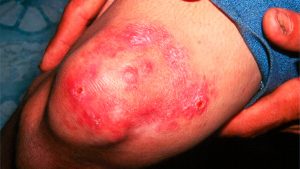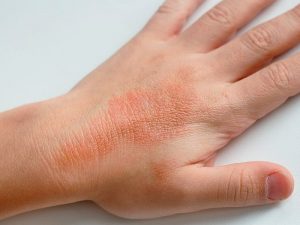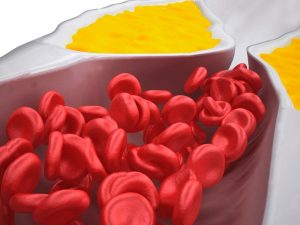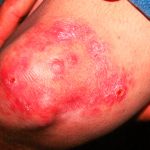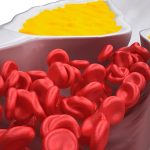Gout is a type of arthritis that occurs when there are high levels of uric acid in the blood. Uric acid is produced when the body breaks down purines, chemical compound found in the body and in food and drinks. When the breakdown process occurs properly, uric acid dissolves in the blood, passing through the kidneys and into urine. Gout occurs when the body produces too much of this acid or the kidneys do not excrete enough of it. The acid can manifest into needle-like crystals around the joints, causing an inflammatory reaction. The onset of gout is sometimes sudden and severe, resulting in pain, tenderness and sometimes swelling.
What Causes Gout?
Gout is an inflammatory condition that affects about 4 per cent of American adults, predominantly men. The Arthritis Foundation lists the following as risk factors:
- Genetics: People with family members who have gout are at a higher risk of developing the condition.
- Pre-existing Conditions: Certain medical conditions, such as high cholesterol, high blood pressure, diabetes and heart disease, can raise the likelihood of developing gout.
- Medications: Medications that raise uric acid levels, such as diuretic medications used for high blood pressure, can contribute to the risk of gout. Immunosuppressant drugs used for rheumatoid arthritis and psoriasis can affect gout development.
- Gender and Age: According to the Arthritis Foundation, six million American men and two million women suffer from gout. After age 60, the risk difference between men and women developing gout evens
- Diet: Dietary choices can play a pivotal role in increasing your chances of developing Certain foods are higher in purine content than others – for example, a high consumption of red meat raises your risk. Doctors recommend keeping red meat consumption to less than 90 grams a day. Harvard Men’s Health Watch says to aim for below 50 grams a day, with evidence that risk of disease increases slightly at 50 grams to 100 grams daily. Sodas are another substance to avoid. Fructose has been shown to increase the risk of gout, according to the Arthritis Foundation, by promoting high levels of uric acid.
- Alcohol Intake: Drinking in moderation can lower your chances of Consuming more than two liquor or beer drinks a day can increase the risk of gout.
- Obesity: People who suffer from obesity are significantly more likely to develop gout, at a younger age, than those at a healthy weight. Overweight people produce more uric acid and the kidneys struggle to eliminate the compound.
- Bypass Surgery: Bypass surgery increases the
Symptoms
Symptoms depend on the stage of the condition and can occur randomly, usually at night.
Main symptoms include:
- Intense joint pain.
- Lasting discomfort.
- Inflammation and redness.
- Range of motion limited.
Stages of Gout
The Arthritis Foundation lists the stages of gout as:
- Asymptomatic Hyperuricemia: In the first stage of gout no symptoms occur. This is the stage when crystals form around the joints due to high blood uric acid levels.
- Acute gout/ gout attack: The condition progresses when something (such as a night of heavy drinking) causes uric acid levels to peak and move the crystals. The symptoms of gout manifest during this spike (or attack), with inflammation and pain that continues to intensify over eight to 12 After a few days, symptoms can subside and usually disappear anywhere from a week to 10 days. It is possible to experience only one gout attack, but 60 per cent of people who have a gout attack will suffer from a second one within a year. Eighty-four per cent of people may have a second attack within three years.
- Interval Gout: This stage signals the period in between gout attacks. There are no pain symptoms during interval gout, but this does not mean the gout has disappeared. Joints can suffer damage during this time, due to low-level inflammation.
- Chronic Gout: When uric acid levels have remained high over several years the condition becomes chronic. Chronic gout results in more frequent attacks and long-lasting pain. Joint damage from this stage can lead to loss of mobility.
Treating Gout
Gout can be painful and cause lasting pain, but there are medications recommended to treat inflammation and pain during attacks. Gout medications not only ease pain, but can lower uric acid levels. Medication alone is not the solution. The right diet and exercise are key to a comprehensive treatment plan. Talk to your healthcare professional to determine medication and treatment.
- Medications for Pain and Inflammation: Colchicine, corticosteroids, non-steroidal anti-inflammatory drugs.
- Medications to Lower Uric Acid Levels: Xanthine oxidase inhibitor, febuxosta, lesinurad, pegloticase, probenecid.
Foods to Avoid
According to the Arthritis Foundation, avoiding or eating in moderation certain foods that are high in purines can reduce gout attacks.
Avoid if possible:
- Organ meats (liver, kidney, brain, tongue).
- Fish/seafood (anchovies, herring, mackerel, whitebait, trout, scallops, caviar, lobster).
- Game (pheasant, rabbit, venison).
- Goose.
- Mincemeat.
- Meat-based liquids (gravies, broth, bouillon).
Moderate-purine foods include:
- Oysters, mussels, shellfish, prawns, shrimp.
- Beef.
- Chicken.
- Turkey.
- Lamb.
- Pork
- Duck.
Diet
Knowing what you can and can’t eat can reduce gout attacks and inflammation pain. The following is a grocery list of purine/uric acid-low foods from the Arthritis Foundation:
- Skim milk and low-fat dairy products.
- Whole-grain foods.
- Plant oils (olive, canola).
- Vegetables.
- Low-fructose fruits.
- Vitamin C supplements.
- Coffee.
- Water.
How to Prevent Gout
Look for foods that are low in purines, keep them to a minimum, limit alcohol intake, and exercise to maintain a healthy weight. If you are at risk, talk to your doctor about further prevention measures.


